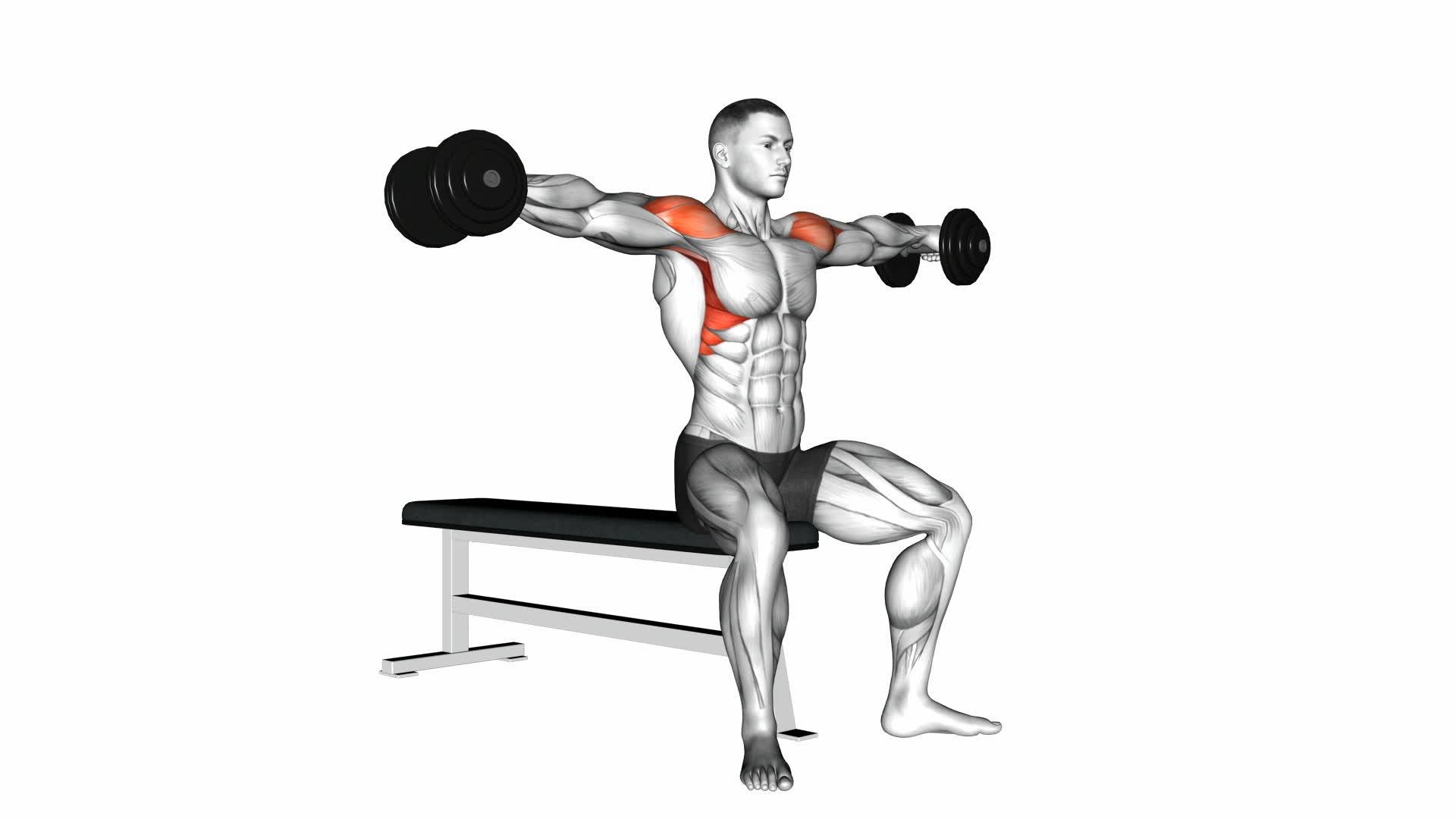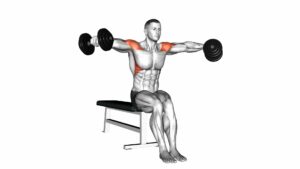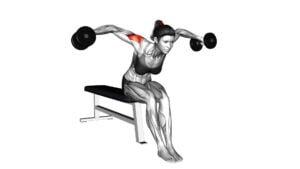Dumbbell Seated Lateral Raise – Video Exercise Guide & Tips

Are you looking to strengthen and tone your shoulders? Look no further than the dumbbell seated lateral raise. This exercise targets your deltoids and helps improve shoulder mobility.
Watch This Exercise Video
In this video guide, you'll discover proper form and technique, common mistakes to avoid, and tips for choosing the right weight.
With variations for progression and expert tips for maximum shoulder activation, you'll be on your way to sculpted shoulders in no time.
Let's get started!
Key Takeaways
- Start in a seated position with proper form and technique
- Avoid common mistakes such as swinging the body or lifting too high
- Choose the right weight that challenges without compromising form
- Incorporate variations for progression to challenge different muscles and promote growth
Proper Form and Technique
To perform the dumbbell seated lateral raise correctly, you should start in a seated position with your back straight and your feet flat on the ground. Begin by holding a dumbbell in each hand, with your palms facing inwards and your arms resting by your sides. Keep your elbows slightly bent throughout the movement.
Slowly raise your arms out to the sides until they're parallel to the ground, making sure to maintain control and avoid any swinging or jerking motions. Pause for a moment at the top of the movement, then slowly lower the dumbbells back down to the starting position.
Remember to focus on engaging your shoulder muscles throughout the exercise, and avoid shrugging your shoulders or using momentum to lift the weights. By performing the dumbbell seated lateral raise with proper form and technique, you can effectively strengthen your shoulders and improve overall shoulder stability and range of motion.
Common Mistakes to Avoid
One common mistake to avoid when performing the dumbbell seated lateral raise is lifting the weights too quickly. This can compromise your form and reduce the effectiveness of the exercise. To ensure proper form and get the most out of your workout, here are some common mistakes to avoid:
- Using momentum: Avoid swinging your body or using momentum to lift the weights. This takes the focus away from your shoulder muscles and can lead to injury.
- Raising the weights too high: While it may be tempting to lift the weights above shoulder level, it's important to stay within a comfortable range of motion. Lifting too high can strain your shoulders and neck.
- Dropping the weights: When lowering the weights, avoid dropping them to your sides. Instead, maintain control and slowly lower them back to the starting position. This will engage your muscles throughout the entire exercise.
- Neglecting proper posture: Sit tall with your back straight and shoulders relaxed throughout the exercise. Avoid slouching or hunching forward, as this can strain your neck and back.
Choosing the Right Weight
Choose the appropriate weight for the dumbbell seated lateral raise based on your current strength and fitness level. It's important to select a weight that challenges you without causing excessive strain or compromising your form. Progression techniques can be used to gradually increase the weight over time as you become stronger.
To determine the right weight for this exercise, start with a conservative choice. Begin with lighter dumbbells, such as 2-5 pounds, and focus on mastering the technique and maintaining proper form. As you become more comfortable and confident, gradually increase the weight by 1-2 pounds at a time.
It's important to note that the weight you choose may vary depending on the specific goals you have for this exercise. If your goal is to build muscle and increase strength, you may need to use heavier weights. On the other hand, if your goal is to improve muscular endurance or tone your muscles, lighter weights may be more appropriate.
If you find that the dumbbell seated lateral raise is too challenging with the weights you have available, there are alternative exercises you can try. Cable lateral raises, resistance band lateral raises, or machine lateral raises can provide a similar movement pattern and allow for easier weight adjustments. Experiment with different exercises to find what works best for you and your current fitness level.
Variations for Progression
As you progress in your strength and fitness journey, incorporating variations for progression in the dumbbell seated lateral raise can be beneficial. These advanced techniques will help you target different muscles and continue challenging your body for continued growth and improvement.
Here are four variations to consider:
- Drop Sets: Start with a heavier weight and perform the exercise until failure. Then, immediately reduce the weight and continue for another set. This technique increases muscle fatigue and promotes muscle growth.
- Supersets: Pair the dumbbell seated lateral raise with another exercise that targets the same muscle group, such as the bent-over lateral raise. Perform one set of each exercise back-to-back without resting. This technique enhances muscle endurance and overall strength.
- Eccentric Training: Focus on the lowering phase of the exercise. Lift the dumbbells with both arms and then slowly lower them with one arm at a time. This technique increases time under tension, promoting muscle hypertrophy.
- Unilateral Raises: Instead of using both dumbbells simultaneously, perform the exercise with one arm at a time. This technique helps improve muscle symmetry and stability.
Incorporating these advanced techniques into your dumbbell seated lateral raise routine will keep your muscles guessing and ensure continued progress in your fitness journey.
Tips for Maximum Shoulder Activation
To maximize shoulder activation during the dumbbell seated lateral raise, focus on maintaining proper form and engaging the deltoid muscles throughout the exercise. This will ensure that you're targeting the shoulders effectively and getting the most out of your workout.
In addition to maintaining proper form, incorporating shoulder mobility exercises and stretches for shoulder activation into your routine can further enhance your shoulder activation during this exercise.
Before performing the dumbbell seated lateral raise, it's important to warm up your shoulders properly. This can be done by performing shoulder mobility exercises such as arm circles, shoulder rolls, and shoulder dislocations. These exercises help to improve the range of motion in your shoulders and prepare them for the lateral raise movement.
Stretching exercises can also be beneficial for activating the shoulder muscles. Try incorporating stretches such as the doorway stretch, across-the-chest stretch, and the sleeper stretch into your warm-up routine. These stretches target the muscles and tendons around the shoulder joint, promoting flexibility and activation.
Frequently Asked Questions
How Many Sets and Reps Should I Do for the Dumbbell Seated Lateral Raise?
To determine the number of sets and reps for the dumbbell seated lateral raise, you should consider your fitness goals and current strength level. Generally, it's recommended to perform 3-4 sets of 8-12 reps to build muscle and increase strength.
However, you can also vary the sets and reps according to your preferences and fitness level. Experiment with different variations of the dumbbell seated lateral raise to challenge your muscles and keep your workouts interesting.
Can I Perform the Dumbbell Seated Lateral Raise Standing Instead of Sitting?
Yes, you can perform the dumbbell seated lateral raise standing instead of sitting. However, it's recommended to perform this exercise in a seated position for optimal results.
The seated position provides stability and isolates the targeted muscles more effectively. It also reduces the chances of using momentum to lift the weights.
Should I Squeeze My Shoulder Blades Together During the Exercise?
To maintain proper form during the dumbbell seated lateral raise, it's important to activate your shoulder blades. By squeezing them together, you engage the muscles in your upper back and ensure that the movement is coming from the shoulders.
This helps to prevent any strain or injury. So, remember to focus on shoulder blade activation throughout the exercise for optimal results.
Is It Normal to Feel a Burning Sensation in My Shoulders While Performing the Dumbbell Seated Lateral Raise?
Feeling a burning sensation in your shoulders during the dumbbell seated lateral raise is normal. This indicates that your shoulder muscles are being activated.
To ensure proper form, keep your back straight, core engaged, and focus on lifting the dumbbells out to the sides until they're parallel to the ground. Avoid using momentum or swinging your arms.
Start with lighter weights and gradually increase as your strength improves.
Can I Use Resistance Bands Instead of Dumbbells for the Seated Lateral Raise Exercise?
Yes, you can definitely use resistance bands instead of dumbbells for the seated lateral raise exercise. Resistance bands offer a different type of resistance that can be beneficial for shoulder exercises. They provide constant tension throughout the movement, which can help strengthen and tone your shoulder muscles.
Additionally, resistance bands are portable and versatile, allowing you to easily modify the intensity of the exercise.
Conclusion
In conclusion, the dumbbell seated lateral raise is an effective exercise for targeting and strengthening the shoulders. By maintaining proper form and technique, avoiding common mistakes, and selecting the appropriate weight, you can maximize the benefits of this exercise.
Additionally, incorporating variations for progression and following tips for maximum shoulder activation will help you achieve optimal results. Remember to consult with a fitness professional if you have any concerns or questions about performing this exercise correctly.

Author
Years ago, the spark of my life’s passion ignited in my mind the moment I stepped into the local gym for the first time. The inaugural bead of perspiration, the initial endeavor, the very first surge of endorphins, and a sense of pride that washed over me post-workout marked the beginning of my deep-seated interest in strength sports, fitness, and sports nutrition. This very curiosity blossomed rapidly into a profound fascination, propelling me to earn a Master’s degree in Physical Education from the Academy of Physical Education in Krakow, followed by a Sports Manager diploma from the Jagiellonian University. My journey of growth led me to gain more specialized qualifications, such as being a certified personal trainer with a focus on sports dietetics, a lifeguard, and an instructor for wellness and corrective gymnastics. Theoretical knowledge paired seamlessly with practical experience, reinforcing my belief that the transformation of individuals under my guidance was also a reflection of my personal growth. This belief holds true even today. Each day, I strive to push the boundaries and explore new realms. These realms gently elevate me to greater heights. The unique combination of passion for my field and the continuous quest for growth fuels my drive to break new ground.







